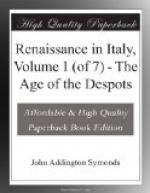[1] Guicciardini (Op. Ined. i. 29) remarks: ’O sia per qualche fato d’ Italia, o per la complessione degli uomini temperata in modo che hanno ingegno e forze, non e mai questa provincia stata facile a ridursi sotto uno imperio.’ He speaks again of her disunion as ’quello modo di vivere che e piu secondo la antiquissima consuetudine e inclinazione sua.’ But Guicciardini, with that defect of vision which rendered him incapable of appreciating the whole situation while he analyzed its details so profoundly, was reckoning without the great nations of Europe. See above, pp. 40, 41.
After 1200 the problem changes its aspect. We have now to ask ourselves why, when the struggle with the Empire was over, when Frederick Barbarossa had been defeated at Legnano, when the Lombard and the Tuscan Leagues were in full vigor before the Guelf and Ghibelline factions had confused the mainsprings of political activity, and while the national militia was still energetic, the Communes did not advance from the conception of local and municipal independence to that of national freedom in a confederacy similar to the Swiss Bund. The Italians, it may be suggested, saw no immediate necessity for a confederation that would have limited the absolute autonomy of their several parcels. Only the light cast by subsequent events upon their early history makes us perceive that they missed an unique opportunity at this moment. What they then desired was freedom for expansion each after his own political type, freedom for the development of industry and commerce, freedom for the social organization of the city beloved by its burghers above the nation as a whole. Special difficulties, moreover, lay in the way of confederation. The Communes were not districts, like the Swiss Cantons, but towns at war with the Contado round them and at war among themselves. Mutually jealous and mistrustful, with a country population that but partially obeyed their rule, these centers of Italian freedom were in a very different position from the peasant communities of Schwytz, Uri, Untenvalden. Italy, moreover, could not have been federally united without the consent of Naples and the Church. The kingdom of the Two Sicilies, rendered definitely monarchical by the Norman Conquest, offered a serious obstacle; and though the Regno might have been defied and absorbed by a vigorous concerted movement from the North and center, there still remained the opposition of the Papacy. It had been the recent policy




